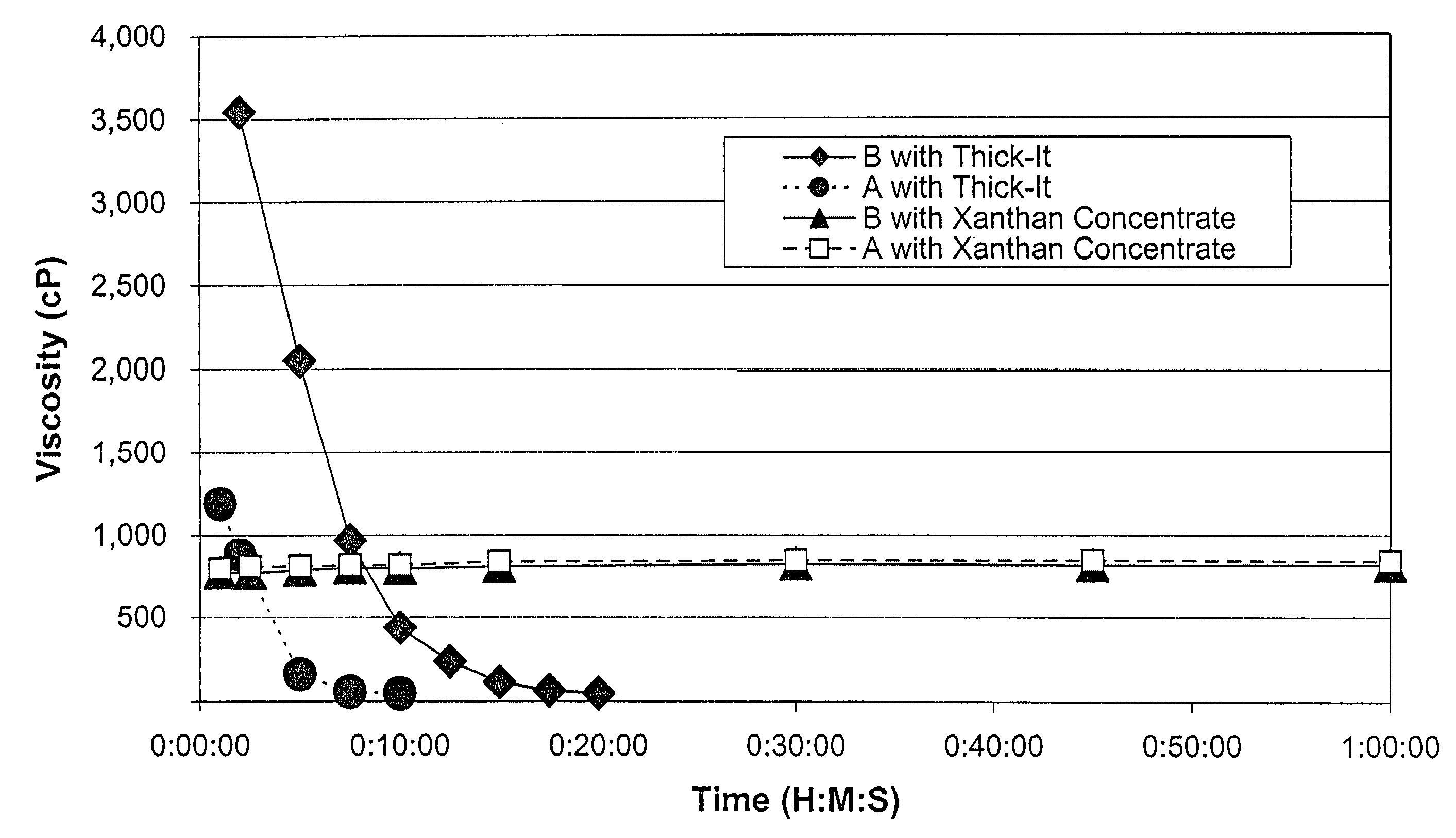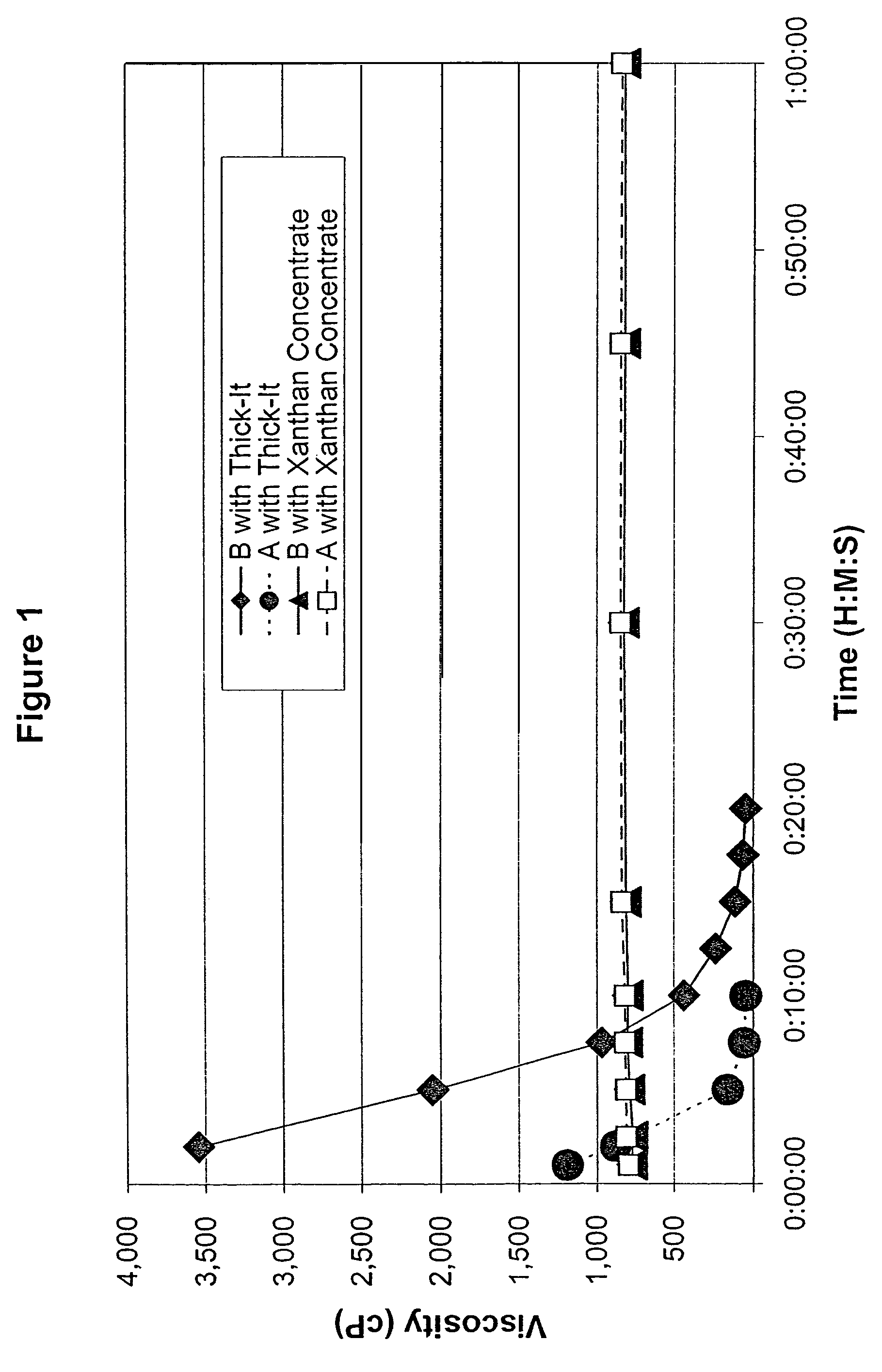Process for preparing concentrate thickener compositions
a technology of concentrate and thickener, which is applied in the field of concentrate thickener compositions, can solve the problems of discomfort in swallowing, difficulty in swallowing, and inability to swallow, and achieve the effects of convenient dispersal, convenient dispersal, and convenient dispersal
- Summary
- Abstract
- Description
- Claims
- Application Information
AI Technical Summary
Benefits of technology
Problems solved by technology
Method used
Image
Examples
example 34
[0067]This example demonstrates that the thickener concentrates of this invention have reduced changes in viscosity over time and tat they have less variability in final thickness. Eight ounces of honey consistency beverages were prepared with a commercially available starch thickener, Thick-It® starch thickener (Precision Foods, St. Louis, Mo. USA), by following the manufacturer's directions on the can. 5 tablespoons of powder was added to each beverage and mixed for a few seconds with a whisk. Each thickened liquid food was allowed to stand for at least 30 seconds. The thickened liquid foods were prepared in water, apple juice, cranberry juice cocktail, prune juice and orange juice.
[0068]A thickener concentrate was prepared with 3.75% clarified xanthan gum, 0.25% citric acid, 0.1% sodium benzoate, and 0.1% potassium sorbate. This was heat processed for shelf stability and packaged in 25 g aliquots into foil pouches. Nine months later, two of these packets were added to 8 oz. of ea...
example 35
[0073]The following example demonstrates the benefits of the preferred thickener concentrates in terms of preference, taste, and appearance. By improving these characteristics, patients will consume greater quantities of beverage.
[0074]In this Example, fourteen human patients of a long-term care facility were offered water and orange juice thickened with a commercial product, Thicken Right (Manufactured by Diamond Crystal Specialty Foods USA). In addition, they were offered water and orange juice thickened with compositions of the invention. A thickener concentrate was prepared with 3.75% clarified xanthan gum, 0.25% citric acid, 0.1% sodium benzoate, and 0.1% potassium sorbate. This was beat processed for shelf stability and packaged in either 10 g or 25 g aliquots in foil pouches. After three months, the packets were added to the liquid foods at a rate of one packet per 4 oz. of liquid food and agitated with a whisk to achieve thickening. Patients on a nectar-consistency diet were...
example 36
[0092]To further demonstrate the effectiveness of the xanthan thickener concentrate in human breast milk, the samples from Example 35 35 thickened with the xanthan concentrate were frozen. Six days later, the frozen samples were allowed to thaw in a refrigerator. Two days later they were warmed to room temperature and their viscosity was measured again. The samples showed no signs of separation when the samples were opened. The viscosity of the B breast milk thickened with the xanthan concentrate was 868 cP and the A breast milk thickened with the xanthan concentrate was 920 cP. (cP=centipoise.)
[0093]The xanthan gum thickener concentrate thickens human breast milk and maintains the thickness without significant changes in consistency. This is true even when frozen for six days and refrigerated for another two days. This is a dramatic improvement over existing technology where thickness is not maintained for even 20 minutes.
[0094]Examples 37 and 38 demonstrate that the improved taste...
PUM
 Login to View More
Login to View More Abstract
Description
Claims
Application Information
 Login to View More
Login to View More - R&D
- Intellectual Property
- Life Sciences
- Materials
- Tech Scout
- Unparalleled Data Quality
- Higher Quality Content
- 60% Fewer Hallucinations
Browse by: Latest US Patents, China's latest patents, Technical Efficacy Thesaurus, Application Domain, Technology Topic, Popular Technical Reports.
© 2025 PatSnap. All rights reserved.Legal|Privacy policy|Modern Slavery Act Transparency Statement|Sitemap|About US| Contact US: help@patsnap.com



